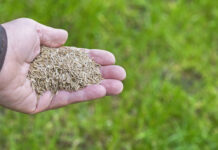Grant projects help make lemonade from economic lemons for landscapers
|
Michigan is as tough a landscaping market as exists in the U.S. today. The state’s largest city, Detroit, has an unemployment rate near 30 percent. Ranked eighth in the country for its foreclosure rate, three of Michigan’s five worst counties (averaging 3.3 percent foreclosures) are bedroom communities that house families of laid-off auto industry laborers and executives.
Municipalities, long a staple in the landscaper’s portfolio of steady customers, have watched revenue sharing fall by 40 percent in the last five years.
Chris Lehr owns a landscape firm in Michigan. He’s discovered that when the market no longer delivers money, the best response is to write a grant. It’s a side enterprise he developed while attending college at Michigan State University. Instead of just bidding on grant-funded jobs, he either writes the grants himself, or he helps the client do it, usually for a consulting fee.
Community partnership
The latest landscape grant-funded project is one born from a partnership with a Detroit-area business and landowner association called the West Grand River Boulevard Collaborative. Covering a 10-city-block stretch located within the west-central region of the city, the group’s members include Henry Ford Hospital, the Health Alliance Plan, a collection of churches, museums, small businesses and landowners.
Collaborative President Mildred Hunt Robbins says, “Our goal is to create a safer and more aesthetic appeal for the area.”
It began with a $58,000 HUD grant-funded area signage project and a volunteer, weekly trash cleanup program dubbed “No Trash Left Behind.” Over the last three years, using the studies commissioned from three local universities, Wayne State University, the University of Detroit-Mercy and Lawrence Tech, the collaborative crafted a master development plan for their area.
A major component of this plan is a proposed greening of area businesses. The Wayne County Landscape Department chief referred Lehr to the collaborative owing to his involvement with a riverbank restoration involving some local businesses and area parks. It was a good fit: Robbins and her members wanted to green their area, but they had no idea how to proceed.
Demonstration site
After reviewing the collaborative’s plan, Lehr realized the size of the area and the number of businesses and projects proposed represented a huge number of projects that might keep him busy for years.
Since a number of the projects will likely be municipality-run, he will have an opportunity to bid on each job as it comes up. As one of the plan’s early architects, he’s already made contacts with all the partners, the association, the city and some granting agencies.
“My efforts started with my donating services to create a concept that will be useable throughout the collaborative’s area,” Lehr says. “That’s usually the first step, anyway, when you write a grant, creating a concept plan.”
Normally, he gets paid to write or to assist in writing grants. “While I charge from $500 to $1,000 for a grant application, I believed, and still believe, the gratis work will more than pay for itself.”
|
Lehr built the concept on the Duffield Branch of the Detroit City Library, located on the eastern side of the association’s turf. The collaborative donated a $3,500 seed grant to fund the initial work on the “demonstration site.”
Working with the collaborative’s part-time grant writer, Lehr helped write an EPA grant to fund the creation of a green landscape demonstration site on the Duffield Branch’s property. The seed money paid for the removal of the scruffy hedge, a native-plant landscape along the entry walkway and in front of the main entrance, and an outdoor classroom.
“The ‘council ring,’ as I call it, consists of 10 boulders set in a ring near one of the larger trees we put on the site,” Lehr says. “The library will use its reading garden for outdoor education programs, a number of which, under the terms of the grant, will focus on environmental education.”
A large privet hedge surrounded the structure, obscuring the building view from the street. Area residents said it created a safety hazard, and its vegetation was either overgrown or well past its prime. There were large bare spots in the lawn, and the lawn area was quite large.
“Everything was run-down. There were volunteer trees and shrubs where there used to be beds,” he recalls.
Native mixes were unsuitable. “We needed the open area for the reading garden. We used a low-growing fescue mix for the turf and surrounded it with native gardens, which will eventually feature sculpture provided by a local nonprofit,” Lehr says.
One plan feature includes a substantial reduction of the site’s open turf areas. “This design cut their mowing costs by 70 percent,” he says.
Another bonus this design delivers is reduced environmental treatment costs. With fewer turf areas, rainwater runoff will get far more filtration before it hits the stormwater system.
Lehr placed the gardens to intercept and capture runoff from all roof and hard surfaces. Instead of running off directly into the storm system and, eventually, a treatment plant, much of it will percolate into the ground.
It wasn’t an easy installation, Cameron, Chris’ son, recalls. He supervised the crew in the construction phase of the project.
“Despite having a skid steer donated by the local Habitat for Humanity group at our disposal, it was a pretty small site on a heavily trafficked road,” he says. “We needed to be very careful of the surrounding property as well as the traffic on the road.”
Nativescape LLC
Chris and Cameron have owned and operated their native plant landscape and nursery operation since 1998. Their ecological services firm is located in Manchester, Mich.
“These days, we are a consulting service involved in native plant growing and brokering, bioengineering, environmental wetland assessment and delineation and landscaping,” Lehr says.
Put simply, once a site is cleared, their landscape crews go in and execute a plan to restore it to a more natural state. “We have the seed, the skills and the plant materials to do it,” he says.
They grow 25 Michigan and Great Lakes-region native species in their nursery and use it almost exclusively for their own projects. The Lehrs wholesale some wetland and common species custom mixes.
When they sell plants at all, they either sell their surplus production or procure it from a giant list of native plant nurseries Lehr has compiled over the years. “If we can’t find it, it can’t be had,” he says.
With an economic recovery for Detroit nowhere in sight, waiting for local government to write grants is not the answer. Firms that write their own grants can put projects on a faster track than those who wait for local government to devote the resources to taking that first step.
Larger firms might want to investigate hiring their own grant writers. Universities are loaded with people who have this kind of skill. Many good graduate programs begin teaching grad students how to write grants at the beginning of their studies, and there are numerous agriculture, horticulture and turf students equipped to help management turn urban beautification programs into green opportunities.
While the first chapters are completed, with luck the true completion of the West Grand River Boulevard landscape project is several years, and several more grants, from realized. However, the early success of grant-funded grounds work indicates it has potential to be a perennially good business idea.
Grant Writing for ProfitChris Lehr says the library demonstration site will serve two audiences. The first group is neighboring businesses within the West Grand River corridor. A larger audience Lehr hopes will respond is the city fathers and those from surrounding municipalities. The corridor offers a design that can be used in a number of venues, he says. The grants he is writing will fund other site improvements, such as permeable pavement, rain gardens, a bioswale, retention basins, and prairie and turf areas. The first thing to remember when writing grants is to have a concept plan in place. “Having before and after photos from previous similar projects is very helpful,” he says. Next, be able to lay out how the construction will be accomplished step by step. Finally, list the benefits the project will create once complete. It is essential that you can show how the project meets the goals of the grant. “You have to be able to show how your project will fulfill the requirements of the grant program,” says Lehr. “You have to be able to put it all into a concise package.” Another crucial component of a grant application is being able to document community involvement. Be sure to include letters from all community partners supporting the program, as well as details of any resources they are providing to the project. When applying for matching grants, grants that will pay for a certain percentage of the project costs, remember to include things like use of city maintenance crews doing the work or use of municipal equipment. “In many cases, use of ‘in-kind services’ like this will cover your side of the matching grant, he says. “As long as money from other grants isn’t earmarked for specific use, you can use it to pay for the first match to get the whole thing paid for.” |
David Weinstock is an assistant professor of communications/journalism and holds a Mass Media Ph.D. Curt Harler, who has a B.S. in agriculture from Penn State University and an M.S. in ag from The Ohio State University, is a full-time freelance writer specializing in green topics.











![[VIDEO] Dickies®: Discover Workwear That’s Anything But Uniform](https://turfmagazine.com/wp-content/uploads/2023/06/1647663814-4b1a2a7742790a9b1e97a3b963477850192e1d6a9dfba9b07214a77bae25d6e3-d-218x150.jpg)

































![[VIDEO] Dickies®: Discover Workwear That’s Anything But Uniform](https://turfmagazine.com/wp-content/uploads/2023/06/1647663814-4b1a2a7742790a9b1e97a3b963477850192e1d6a9dfba9b07214a77bae25d6e3-d-324x160.jpg)